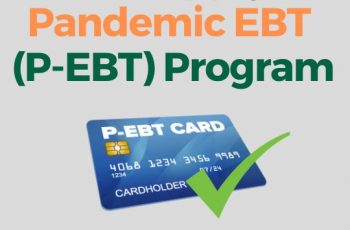Pandemic Electronic Benefit Transfer (P-EBT) Program benefits will soon be distributed to families of over 1 million children. These benefits will help each family cover the cost of breakfasts and lunches their children would have been eligible to receive for free or at a reduced price through the National School Lunch Program.
Pandemic Electronic Benefit Transfer Program FAQs
What is P-EBT?
Pandemic Electronic Benefit Transfer (or P-EBT) was developed by Congress and is funded through the United States Department of Agriculture (or USDA). It’s the federal government that makes the rules for this program. This program gives students with free and reduced-price meal benefits through the National School Lunch Program (or NSLP) funding for meals they missed while being out of school during the pandemic. The money on these cards can be used for food only.
Does my child qualify for P-EBT?
Your child will qualify the child receives meals through the National School Lunch Program (NSLP) and is not receiving those meals because they are not having in-person classes, then they qualify for P-EBT.
Your child is eligible for NSLP if your child has an approved free or reduced-price status from a Household Application, is directly certified by receiving Supplemental Nutrition Assistance Program (SNAP), Temporary Assistance for Needy Families (TANF), or certain Medical Assistance benefits through the Pennsylvania Department of Human Services (DHS), or is enrolled in a CEP school. There is no application for P-EBT.
Your state department that is in charge of the program will work with schools to get the necessary information to determine which students are eligible.
If your child does not fall into any of these categories, then note that they DO NOT qualify for P-EBT. Children that are homeschooled, attend a cyber charter school or are enrolled in a school that does not participate in the NSLP are not eligible for P-EBT.
Note: All students have access to free school meals this school year due to special waivers from USDA. This does NOT mean all students qualify for P-EBT. Meals at school this school year are a different type of federal program.
P-EBT relies on individual student connection to free meals through the NSLP, not their ability to get up free meals from the school.
How much will my child receive?
P-EBT-eligible students will receive a benefit based on whether they were 100 percent virtual, 100 percent in-person, or some combination of virtual and in-person. Students cannot receive benefits on days they attend school in person.
The federal government does not allow for P-EBT to be calculated on the days an eligible student is receiving in-person instruction.
If a student was 100 percent virtual for a month, they will receive 100 percent of the P-EBT benefit for that month. When a student was 100 percent in-person for a month, they will not receive any P-EBT benefit for that month. Then if they were a combination of virtual and in-person for a month, they will receive 65 percent of the P-EBT benefit for that month for the months of September-February.
Because schools are moving to more in-person instruction days, this number may change for the months of March, April and May. Benefits can only be calculated on days when remote learning is taking place.
What should I expect next if my child qualifies?
Beginning in the late Spring, eligible students will receive P-EBT benefits in three stages; the first stage will provide benefits for eligible students for the months of September 2020 through November 2020, the second stage will provide benefits for eligible students for the months of December 2020-February 2021, and the third stage will provide benefits for eligible students for the months of March through May 2021. Stage 2 will begin around the second week of June and Stage 3 will begin in mid-July.
Remember, the amount of benefits received for each child for each phase will vary based on the individual student’s circumstances. The card will come in your child’s name, so keep an eye out for a plain envelope addressed to your household. Each child will receive their own card. Once you have used the Stage 1 benefits on the card, keep the card available because it will be re-used for additional benefits for which your child qualifies.
How do I use the P-EBT benefits?
If your child is currently receiving SNAP or TANF benefits, the P-EBT will be loaded onto your regular Electronic Benefits Transfer (EBT) card into your normal SNAP account, if possible. When you check your SNAP balance, you will not be able to tell the difference between a SNAP deposit and a P-EBT deposit. The P-EBT deposit will have no impact to your regular SNAP or TANF benefits.
If DHS cannot load the benefit onto a SNAP or TANF family’s regular EBT card for some reason, or if your child is not receiving SNAP or TANF benefits, a new P-EBT card will be mailed in your child’s name. If you have multiple children in your household, you will receive multiple cards, but each card will be in each child’s name. Once you receive the P-EBT card, you will need to activate it by calling the P-EBT hotline on the back of the card.
You will be asked to enter the full number on the front of the card. Then you will be asked to enter the last four digits of your social security number. Instead of the last four digits of your social security number, you will need to enter the last four digits of your five digit zip code. You will then be asked to enter your date of birth. Instead, enter the date of birth of the child whose name is on the card. Finally, you will be asked to enter and then confirm a four digit Personal Identification Number (PIN). You may select any four digit combination you want to use but should avoid using repetitive numbers (1111) or sequential numbers (1234).
ALSO SEE: P-EBT Benefits For 2020-2021 School Year
Once you have successfully activated the card and assigned a PIN, the automated voice will tell you that the card has been activated and then disconnect the call. To check the balance on the card, simply call the EBT Hotline number again and any time after the card has been activated, you will get an automated list of options, including options to check the balance of the card, hear the last ten transactions on the card, change your PIN, or dispute charges. You can also check your balance through www.connectebt.com or the ConnectEBT mobile app.
To create your account, you’ll be asked to enter your full social security number but will need to use 000-00 as the first five numbers and then the last four digits of your zip code as the last four numbers and then use the child’s date of birth. Families that receive the benefit onto their regular EBT card can also check their SNAP balance through DHS’ myCOMPASS PA mobile app.
The P-EBT benefits will remain in the SNAP account for nine months after the account is no longer used. For example, if the benefits are loaded in May and never used, they will be removed in February. But if a portion of those benefits are used in July, then the balance will remain on the card until April. It does not matter how much or little of the P-EBT benefit is used, any amount will cause the removal clock to reset.
NOTE: Once benefits have been removed from the card after nine months of inactivity, they cannot be reissued.
What if I Have Not Received my P-EBT or have an issue with my P-EBT?
Due to the large number of cards that must be mailed, it may take until mid to late June for you to receive your card. Please wait until June 30, 2021 to report not receiving a card for your child. If you’ve received your card and are having difficulties activating it or think the benefit amount is incorrect, please review the activation instructions as described above under “How do I use the P-EBT benefit?” and if this does not resolve your issue, please use one of the methods below. The previous issuance of P-EBT was completed back in the late spring and summer of 2020. That issuance was a one-time payment only. It was not a monthly issuance, so if you received a single P-EBT payment, that was all that your child was eligible for during that time.
The benefit removal period for last year’s issuances was six months and was explained in the letter that was sent to eligible families separate from the card. Similarly, once the benefits are removed for inactivity, they cannot be reissued. The only exception is for families that never received the initial card or benefit due to incorrect information being received in the initial issuances.
The P-EBT cards for last year are activated using the same rules as described above under “How do I use the P-EBT benefit?”
Homeschooled children, children enrolled in a cyber charter school, or children attending a school that didn’t participate in the NSLP were not eligible for P-EBT under last year’s issuance.

